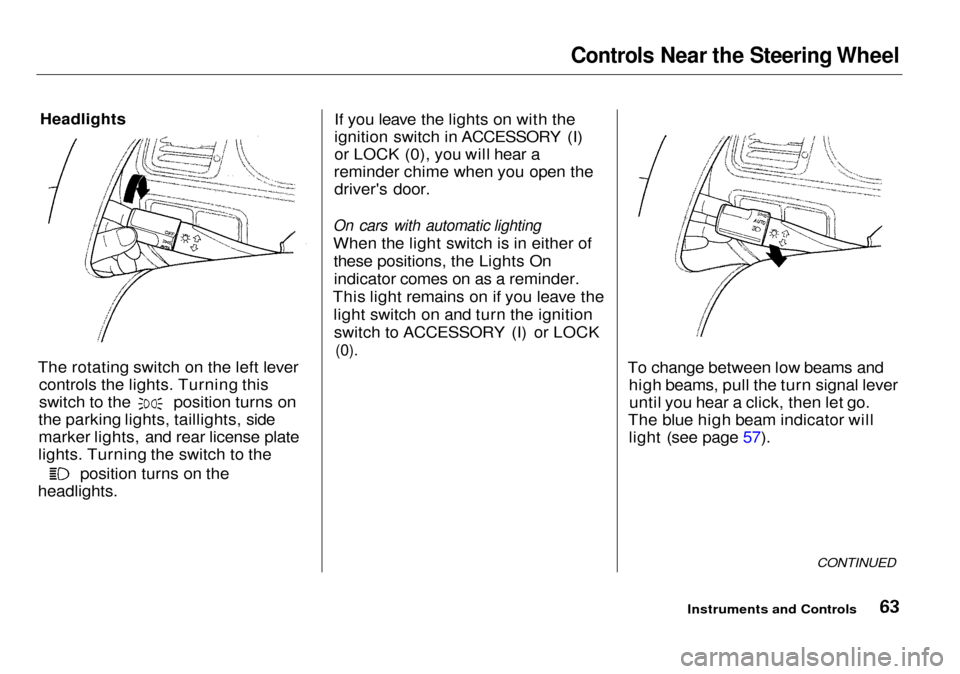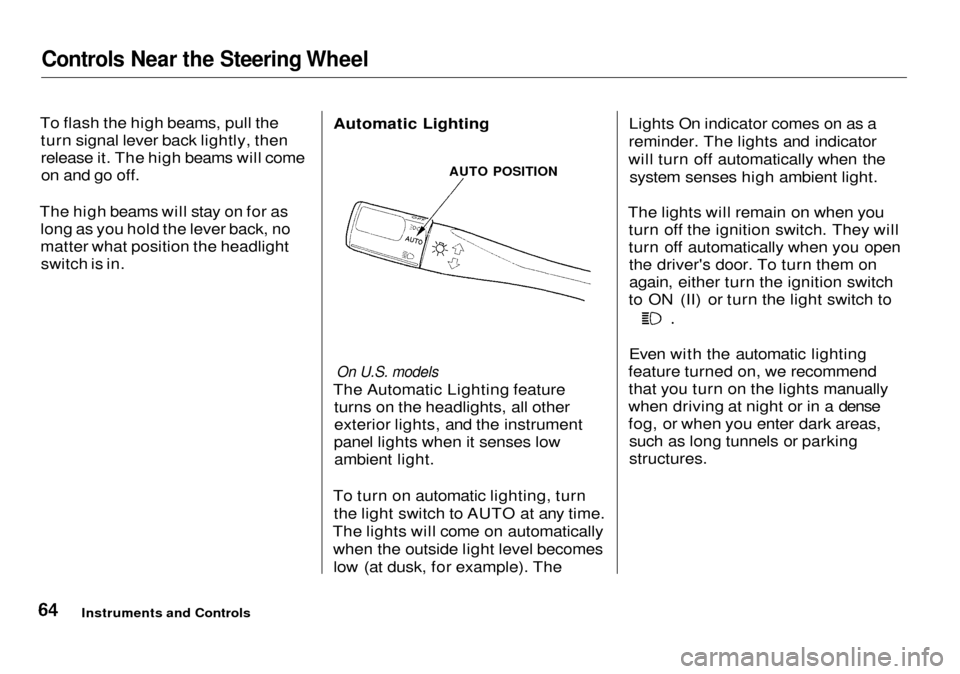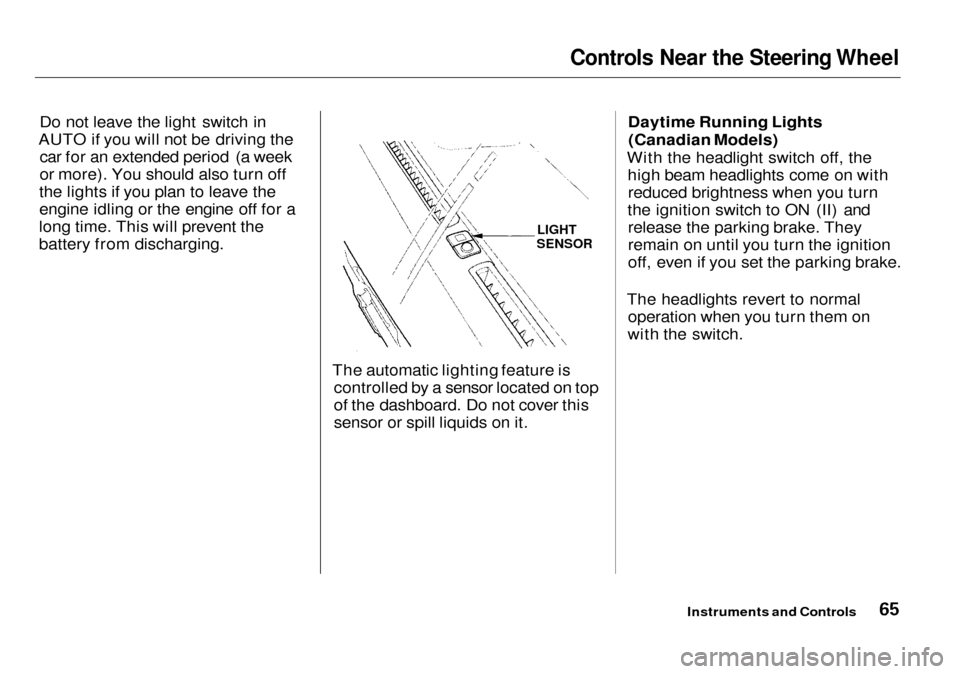ignition Acura RL 2001 3.5 User Guide
[x] Cancel search | Manufacturer: ACURA, Model Year: 2001, Model line: RL, Model: Acura RL 2001Pages: 333, PDF Size: 4.28 MB
Page 61 of 333

Gauges
The gauges illuminate when you turn the ignition switch ON (II).
Speedometer
U.S. Models
This shows your speed in miles per hour (mph). The smaller inner
numbers are the speed in kilometers
per hour (km/h).
Canadian Models
This shows your speed in kilometers per hour (km/h). The smaller innernumbers are the speed in miles per
hour (mph).
Tachometer
The tachometer shows the engine speed in revolutions per minute (rpm). To protect the engine from
damage, never drive with the
tachometer needle in the red zone.
Instruments and Controls
TACHOMETER
SPEEDOMETER
TEMPERATURE
GAUGE
SELECT
BUTTON
MAINTENANCE
REQUIRED INDICATOR
ODOMETER
FUEL GAUGE
TRIP METER/OUTSIDE
TEMPERATURE INDICATOR
RESET
BUTTON
Page 62 of 333

Gauges
Odometer
The odometer shows the total dis- tance your car has been driven. It
measures miles in U.S. models and
kilometers in Canadian models.
It is illegal under U.S. federal law andCanadian provincial regulations to
disconnect, reset, or alter the
odometer with the intent to change
the number of miles or kilometers
indicated.
Trip Meter/Outside Temperature
Indicator
The trip meter and the outside temperature indicator use the samedisplay. To switch the display
between the trip meter and the outside temperature, press the
Select button. When you turn the
ignition switch to ON (II), what you
last selected is displayed.
Trip Meter
The trip meter shows the number of
miles (U.S.) or kilometers (Canada)driven since you last reset it.
There are two trip meters, Trip A and Trip B. Switch between these
and the outside temperature display
by pressing the Select button repeatedly. Each trip meter works
independently, so you can keep track
of two different distances.
To reset a trip meter, display it and then press the Reset button until you
hear a beep. Both trip meters will re-set if the car's battery goes dead or
is disconnected.
CONTINUED
Instruments and Controls
SELECT
BUTTON
RESET
BUTTON
Page 63 of 333

Gauges
Outside Temperature Indicator
This indicator displays the outside temperature in Fahrenheit in U.S.
models, and in Centigrade inCanadian models.
The temperature sensor is located in the front bumper. Therefore, the
temperature reading can be affected
by heat reflection from the road sur-
face, engine heat, and the exhaust
from the surrounding traffic. This can cause the temperature reading
not to be correct when your speed is
under 19 mph (30 km/h).
In certain weather conditions,
temperature readings near freezing (32°F, 0°C) could mean that ice is
forming on the road surface.
Temperature Gauge
This shows the temperature of the
engine's coolant. During normal
operation, the pointer should rise
from the bottom white mark to about
the middle of the gauge. In severe
driving conditions, such as very hot
weather or a long period of uphill
driving, the pointer may rise to near
the upper white mark. If it reaches
the red (Hot) mark, pull safely to the
side of the road. Turn to page 283 for
instructions and precautions on
checking the engine's cooling
system.
Fuel Gauge
This shows how much fuel you have. It is most accurate when the car is on
level ground. It may show slightly
more or less than the actual amount
when you are driving on curvy or
hilly roads.
The gauge stays at the same fuel level reading after you turn off the
ignition. When you add fuel, the
gauge slowly changes to the new
reading after you turn the ignitionswitch back ON (II).
Instruments and Controls
Page 64 of 333

Gauges
Maintenance Required Indicator
This indicator reminds you that it is time to take your car in for scheduled maintenance.
Refer to the Maintenance Schedules
for Normal and Severe Driving Conditions on pages 208— 212
For the first 6,000 miles (9,600 km)
after the Maintenance Required
Indicator is reset, it will come on for
two seconds when you turn the ignition switch ON (II). Between 6,000 miles (9,600 km) and
7,500 miles (12,000 km) this
indicator will light for two seconds
when you first turn the ignition switch ON (II), and then flash for
ten seconds.
If you exceed 7,500 miles (12,000
km) without having the scheduled
maintenance performed, this
indicator will remain on as a constant reminder. Your dealer will reset this indicator
after completing the scheduled
maintenance. If this maintenance is
done by someone other than your
Acura dealer, reset the indicator as follows.
1. Turn off the engine.
2. Press and hold the select and reset buttons next to the instrument pan-
el, then turn the ignition switch
ON (II).
3. Hold the buttons for
approximately ten seconds until
the indicator resets.
Instruments and Controls
SELECT
BUTTON
RESET
BUTTON
MAINTENANCE REQUIRED INDICATOR
Page 66 of 333

Controls Near the Steering Wheel
Headlights
The rotating switch on the left lever controls the lights. Turning this switch to the position turns on
the parking lights, taillights, side marker lights, and rear license plate
lights. Turning the switch to the position turns on the
headlights. If you leave the lights on with the
ignition switch in ACCESSORY (I)
or LOCK (0), you will hear a
reminder chime when you open the driver's door.
On cars with automatic lighting
When the light switch is in either of these positions, the Lights Onindicator comes on as a reminder.
This light remains on if you leave the light switch on and turn the ignitionswitch to ACCESSORY (I) or LOCK
(0).
To change between low beams andhigh beams, pull the turn signal leveruntil you hear a click, then let go.
The blue high beam indicator will light (see page 57).
CONTINUED
Instruments and Controls
Page 67 of 333

Controls Near the Steering Wheel
To flash the high beams, pull the turn signal lever back lightly, then
release it. The high beams will comeon and go off.
The high beams will stay on for as long as you hold the lever back, no
matter what position the headlightswitch is in. Automatic Lighting
On U.S. models
The Automatic Lighting feature turns on the headlights, all other
exterior lights, and the instrument
panel lights when it senses low ambient light.
To turn on automatic lighting, turn the light switch to AUTO at any time.
The lights will come on automatically when the outside light level becomeslow (at dusk, for example). The Lights On indicator comes on as a
reminder. The lights and indicator
will turn off automatically when the system senses high ambient light.
The lights will remain on when you turn off the ignition switch. They will
turn off automatically when you openthe driver's door. To turn them on
again, either turn the ignition switch
to ON (II) or turn the light switch to Even with the automatic lighting
feature turned on, we recommend that you turn on the lights manually
when driving at night or in a dense
fog, or when you enter dark areas, such as long tunnels or parking
structures.
Instruments and Controls
AUTO POSITION
Page 68 of 333

Controls Near the Steering Wheel
Do not leave the light switch in
AUTO if you will not be driving the car for an extended period (a week
or more). You should also turn off
the lights if you plan to leave the
engine idling or the engine off for a
long time. This will prevent the
battery from discharging.
The automatic lighting feature iscontrolled by a sensor located on top
of the dashboard. Do not cover this
sensor or spill liquids on it. Daytime Running Lights
(Canadian Models)
With the headlight switch off, the high beam headlights come on withreduced brightness when you turn
the ignition switch to ON (II) and release the parking brake. They
remain on until you turn the ignition
off, even if you set the parking brake.
The headlights revert to normal operation when you turn them on
with the switch.
Instruments and Controls
LIGHT
SENSOR
Page 74 of 333

Controls Near the Steering Wheel
Rear Window Defogger
Th
e rear window defogger will clear
fog
, frost, and thin ice from the
window. Push the defogger button to turn it on and off. The light in the
button lights to show the
defogger is
on. If
you do not turn it off, the
defogger will shut itself off after
about
25 minutes. It also shuts off
when you turn off the ignition. You have to turn it on again when you
restart the car. Make sure the rear window is clear
an
d you have good visibilit
y before
starting to drive.
The defogger and antenna wires on the inside of the rear window
can be
accidentally damaged. When
cleaning
the glass, always wipe side
to side. Steerin
g Wheel Adjustments
See page 17 for important safety
information about how to properly
position the steering wheel.
You
r Acura's
steering wheel is
electrically-adjustable
for angle and
distance. The adjustment switch is
on the left side of
the steering
column.
Always adjust the steering
wheel before you begin driving.
CONTINUED
Instruments and Controls
Adjusting the steering wheel
position while driving may
caus
e you to lose control o
f the
car
and be seriously injured in a
crash.
Adjust the steering wheel only
when
the car is stopped.
Cars with navigation system
Page 75 of 333

Controls Near the Steering Wheel
1. Locate the adjustment switch on the left side of the steering column.Move the steering wheel, in, out,
up, or down by pushing and
holding the adjustment switch in
that direction. 2. Release the switch when the
steering wheel reaches the
desired position. Make sure the
steering wheel points towards
your chest, not toward your face, and that you can see the
instrument panel gauges and
warning lights. The AUTO switch controls automat-
ic movement of the steering wheel.
When this switch is in the ON posi- tion, the steering wheel automatical-
ly moves fully in and up when you re-
move the key from the ignitionswitch.
Instruments and Controls
Automatic Movement
AUTO SWITCH
Page 76 of 333

Controls Near the Steering Wheel, Steering Wheel Controls
The steering wheel then returns to its original position when you insert
the key back in the ignition switch.
Steering wheel movement is also
controlled by the Driving Position
Memory System (see page 101). Cruise Control
Cruise control allows you to maintain
a set speed above 25 mph (40 km/h)
without keeping your foot on the accelerator pedal. It should be used
for cruising on straight, open highways. It is not recommended forconditions such as city driving,
winding roads, slippery roads, heavy rain, or bad weather. You should
have full control of the car under
those conditions. Using the Cruise Control
1. Push in the Cruise Control Master Switch to the left of the steering
column. The indicator in theswitch will light.
2. Accelerate to the desired cruising speed above 25 mph (40 km/h).
CONTINUED
Instruments and Controls
CRUISE CONTROL MASTER SWITCH
Improper use of the cruise
control can lead to a crash.
Use the cruise control only
when traveling on open highways in good weather.